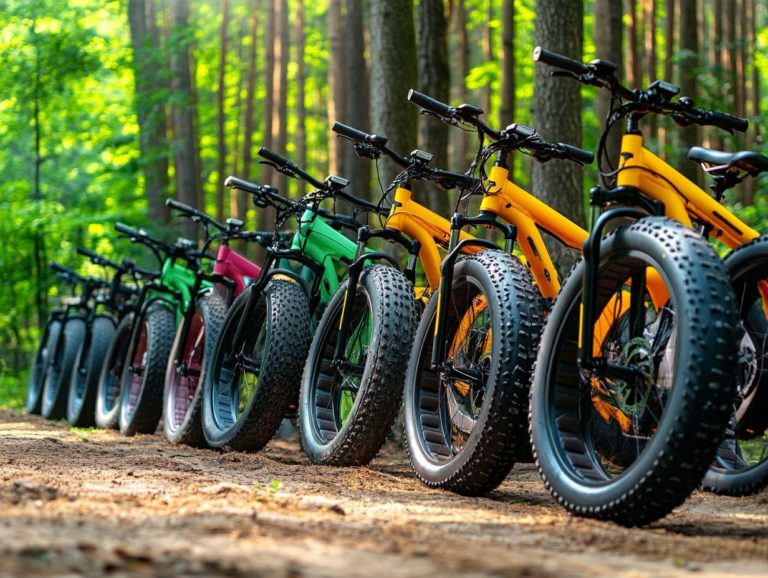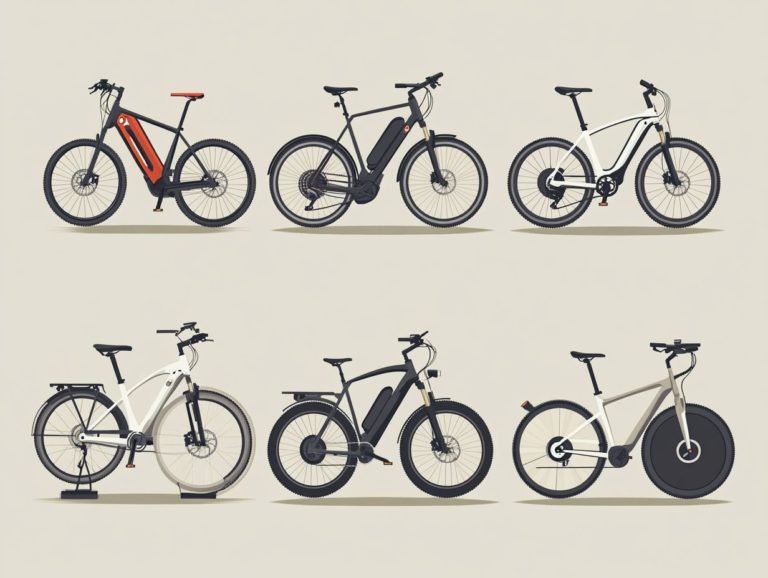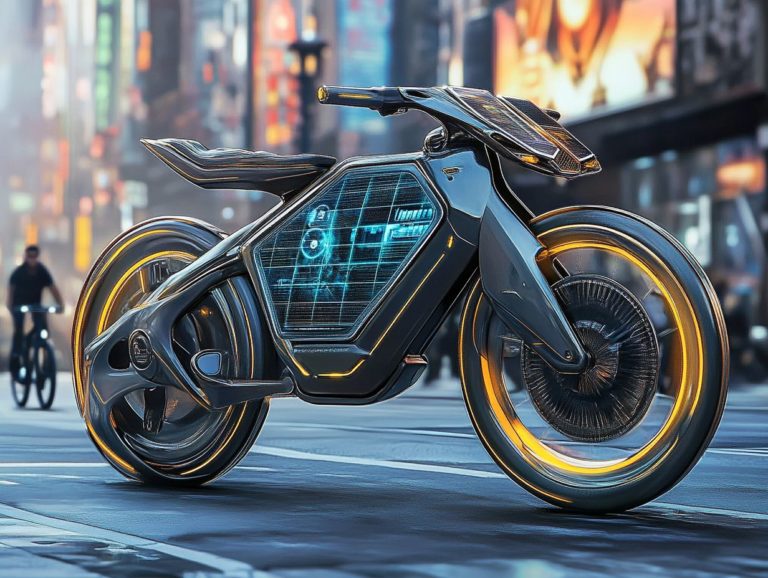5 Key Differences Between E-Bike Types
Choosing the right e-bike can feel overwhelming with so many options available today, including various types such as pedal-assist and throttle-only e-bikes.
The type of pedal assist and the position of the battery are crucial for your riding experience. This guide highlights five exciting differences between e-bike types that will help you make the best choice.
It also examines the benefits and limitations of each type, guiding you on how to select the perfect e-bike tailored to your needs, while considering the environmental impacts involved and the laws that differ by state. Whether you re a daily commuter or a weekend adventurer, this guide will empower you to make a well-informed choice.
Contents
- Key Takeaways:
- 1. Pedal Assist vs Throttle Control
- 2. Battery Placement
- 3. Motor Placement
- 4. Speed and Range
- 5. Price and Affordability
- What Are the Different Types of E-Bikes?
- Frequently Asked Questions
- What are the 5 key differences between E-Bike types?
- How does motor placement differ among E-Bike types?
- What is the main distinction between pedal assist and throttle E-Bike types?
- Where is the battery typically located on E-Bikes?
- What is the maximum speed of E-Bikes?
- How does range differ among E-Bike types?
Key Takeaways:
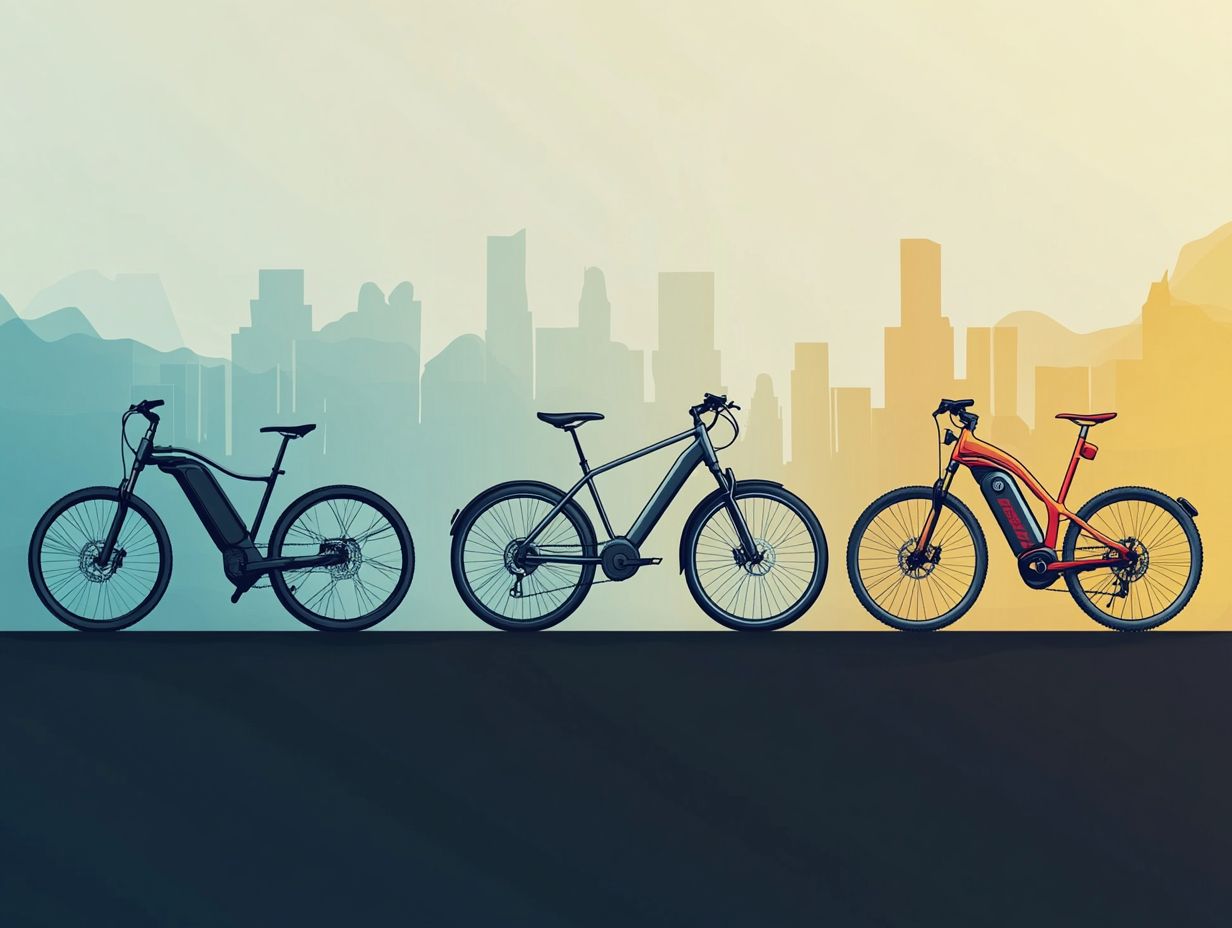
- Pedal assist and throttle control are the two main ways to power an e-bike, with pedal assist providing a more natural and efficient riding experience.
- Battery placement can greatly affect the balance and stability of an e-bike. Frame-integrated batteries are the most inconspicuous, while rear rack batteries provide convenient access for charging.
- The placement of the motor impacts the handling and weight distribution of an e-bike. Hub motors are the most common, while mid-drive motors offer a more natural riding experience.
1. Pedal Assist vs Throttle Control
Pedal assist and throttle control are two distinct features in e-bikes that can significantly shape your riding experience. They cater to your unique preferences, whether you’re out for recreational riding or commuting through the city.
With pedal assist, every journey feels more like traditional cycling. You actively pedal to receive assistance, which can even boost your fitness levels. This system tends to ease the strain on your body, making it a fantastic choice for tackling those challenging hills.
Conversely, throttle control offers a more effortless ride. You can engage the motor without pedaling, which is perfect for navigating bustling city streets or simply taking a breather from pedaling.
Take models like the Unagi Model One Voyager and Lectric XP 3.0. They exemplify the smooth acceleration that throttle control provides and are perfect for navigating bike lanes. Meanwhile, the Lectric XP 3.0, featuring a robust pedal assist system, adapts beautifully across various terrains, minimizing the need for extensive safety gear.
Understanding these features is crucial don t miss out on the perfect e-bike for your needs!
2. Battery Placement
The placement of batteries in e-bikes is paramount for optimizing your riding experience and ensuring stability. It influences how you navigate various terrains and conditions.
For instance, when the battery is integrated within the frame, it typically lowers the center of gravity, enhancing both balance and maneuverability making those hilly rides much more manageable. On the other hand, if you choose a model with a battery mounted on a rear rack, like some from Juiced Bikes, you may find the weight distribution tilting towards the back. This can affect handling, especially during cornering or sudden stops.
Each choice regarding battery placement carries significant implications for your rider comfort and the responsiveness of your bike across different riding conditions. Ultimately, grasping these dynamics will empower you to make more informed decisions when selecting your ideal e-bike.
3. Motor Placement
Motor placement in electric bikes plays a crucial role in shaping your riding performance and experience. It affects key factors like torque, speed, and overall handling, especially in varying riding conditions and different terrains.
Understanding the differences between hub motors and mid-drive systems can help you choose the configuration that best suits your riding style. Hub motors, usually nestled in the wheel, offer a straightforward and user-friendly experience. This makes them a favorite among commuters who prioritize efficiency over rugged terrains.
Conversely, mid-drive motors are located near the bike’s bottom bracket. They provide better power when climbing hills and enhance balance, improving stability and maneuverability on challenging trails. If you re the adventurous type who relishes off-road excursions, mid-drive options are likely your best bet for conquering steep inclines.
Meanwhile, if you navigate the city streets, you might find hub-driven bikes offer effortless rides on smooth surfaces.
4. Speed and Range
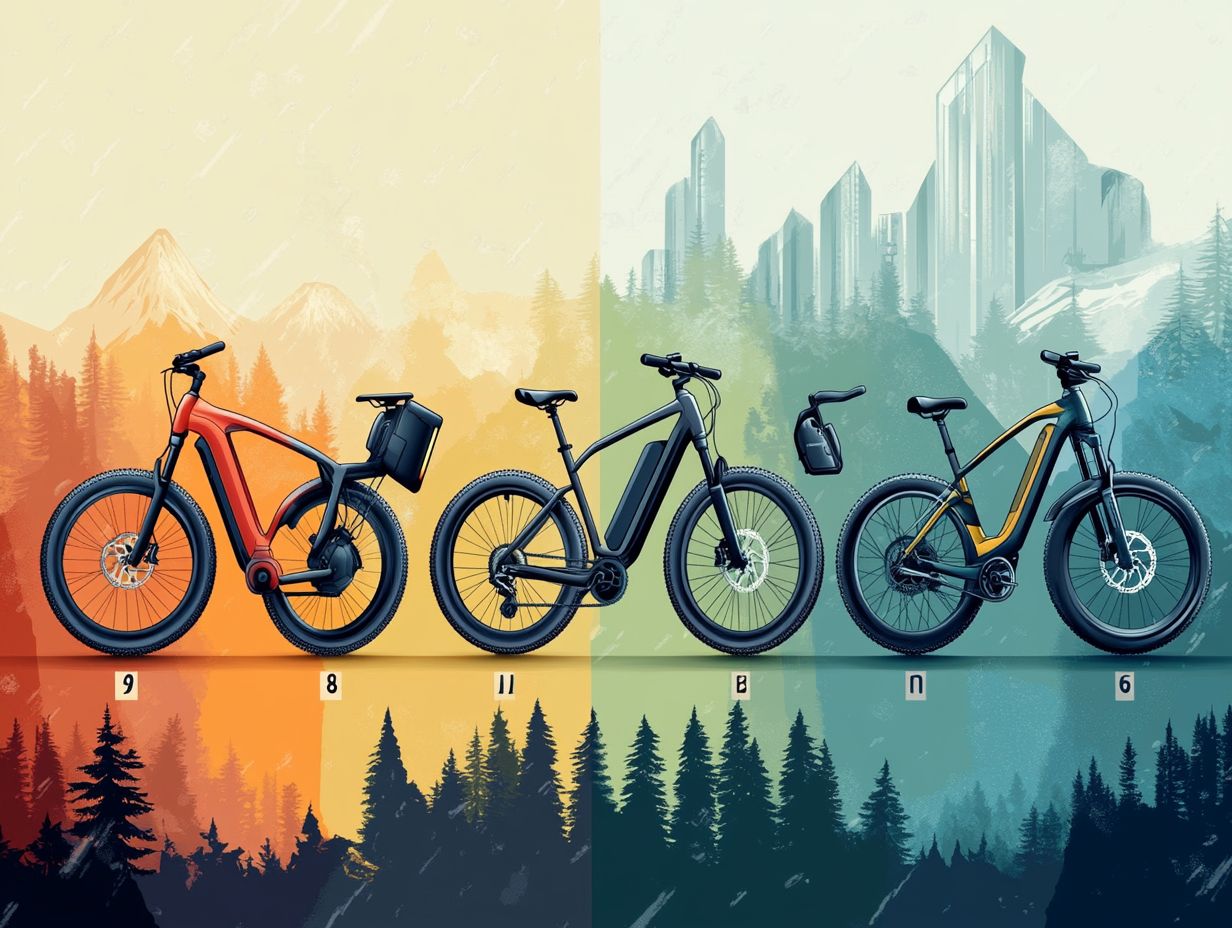
Understanding speed and range is crucial for you as an electric bike enthusiast. These elements dictate how practical an e-bike can be for your various needs, whether you’re commuting on a fast e-bike or enjoying a leisurely ride on a folding e-bike.
Each Class type Class 1, Class 2, and Class 3 has its own maximum speed limits, which can greatly influence your experience on the road. For example, Class 1 bicycles cap out at 20 mph unless you’re pedaling. Class 3 models can soar up to 28 mph, appealing to those who seek a bit of excitement in their ride.
Battery capacity significantly affects your range; a higher capacity battery extends your travel distance and improves performance at speed. This is super important for riders who love speed! Those who enjoy fast e-bikes or electric motorcycles relish the promise of extended performance and the freedom that comes with longer journeys. When choosing an electric mountain bike, consider the 5 features to look for to ensure you make the best choice.
5. Price and Affordability
Price and affordability are pivotal factors in your journey as a potential electric bike buyer. A diverse array of options is available to suit various budgets and preferences, including electric kick scooters and well-designed seats for added comfort.
As you navigate the electric bike market, you’ll notice that costs can fluctuate dramatically based on the type of bike you choose, be it a folding e-bike, a cargo e-bike, or a speed pedelec. Each category, from commuter e-bikes to top electric bicycle types for commuters, has its unique advantages, often reflected in their respective price points.
For instance, folding e-bikes typically come at a more accessible price, making them ideal for urban dwellers who prioritize convenience and storage. On the other hand, cargo e-bikes are generally priced higher due to their sturdy construction and additional features designed for transporting goods. To make an informed choice, consider comparing different electric bicycle designs.
If you’re leaning toward speed pedelecs, be prepared for a premium price tag, as their powerful motors and extended battery life come at a cost. If you’re working within a tighter budget, entry-level models are certainly an option. However, investing in quality choices like the Aventon Soltera.2 or HyperFat will yield better performance and longevity. For a deeper understanding of different options, check out this quick guide on electric bicycle classification.
Ultimately, these choices deliver exceptional value over time, ensuring a satisfying ride well into the future.
What Are the Different Types of E-Bikes?
The world of electric bikes (e-bikes) is a rich variety, featuring various models tailored to meet your specific riding needs. Whether you’re looking for commuter e-bikes for urban adventures or mountain e-bikes for conquering rugged terrains, each type comes with its own unique features and advantages.
Regarding commuter e-bikes, they prioritize your convenience and efficiency, showcasing lightweight frames and strategically placed batteries that ensure optimal balance.
If you’re seeking thrills on challenging trails, mountain e-bikes are your go-to; they re built tough, equipped with sturdy suspension systems mechanisms that absorb shocks for a smoother ride and powerful motors that enhance traction on steep inclines.
On the other hand, if transporting heavy loads is your priority, cargo e-bikes are designed with sturdiness and practicality in mind, often featuring sturdy racks and reinforced frames that meet e-bike rules.
Get ready to explore! Your choice will depend on the environments you plan to tackle, the distances you aim to cover, and the cycling trends in your area. For more guidance, check out city vs. mountain: choosing your electric bicycle type. Battery and motor placement are key factors that will significantly influence the performance and handling of the e-bike you select.
What Are the Benefits and Limitations of Each Type?
Each type of electric bike offers unique benefits and limitations that can influence your choice based on your specific needs and riding conditions, whether you’re navigating urban streets or embarking on off-road adventures.
For instance, if you’re an urban commuter, you might find yourself drawn to the convenience and speed of city e-bikes, expertly designed for quick navigation through traffic. However, be prepared to consider their weight, the higher price tag, and the varying laws by state that often accompany these models. Additionally, choosing the right electric bicycle type for you can greatly enhance your commuting experience.
On the flip side, cargo e-bikes cater to families and businesses alike by providing ample storage space for groceries or deliveries, making them incredibly practical for daily errands. Just be aware that their sturdy design can mean more maintenance.
If you’re hitting rugged trails, mountain e-bikes shine with powerful motors and advanced suspension systems tailored for challenging terrain. Keep in mind, though, that they can be heavier and pricier compared to simpler models designed for city riding.
How Can One Choose the Right E-Bike Type for Their Needs?
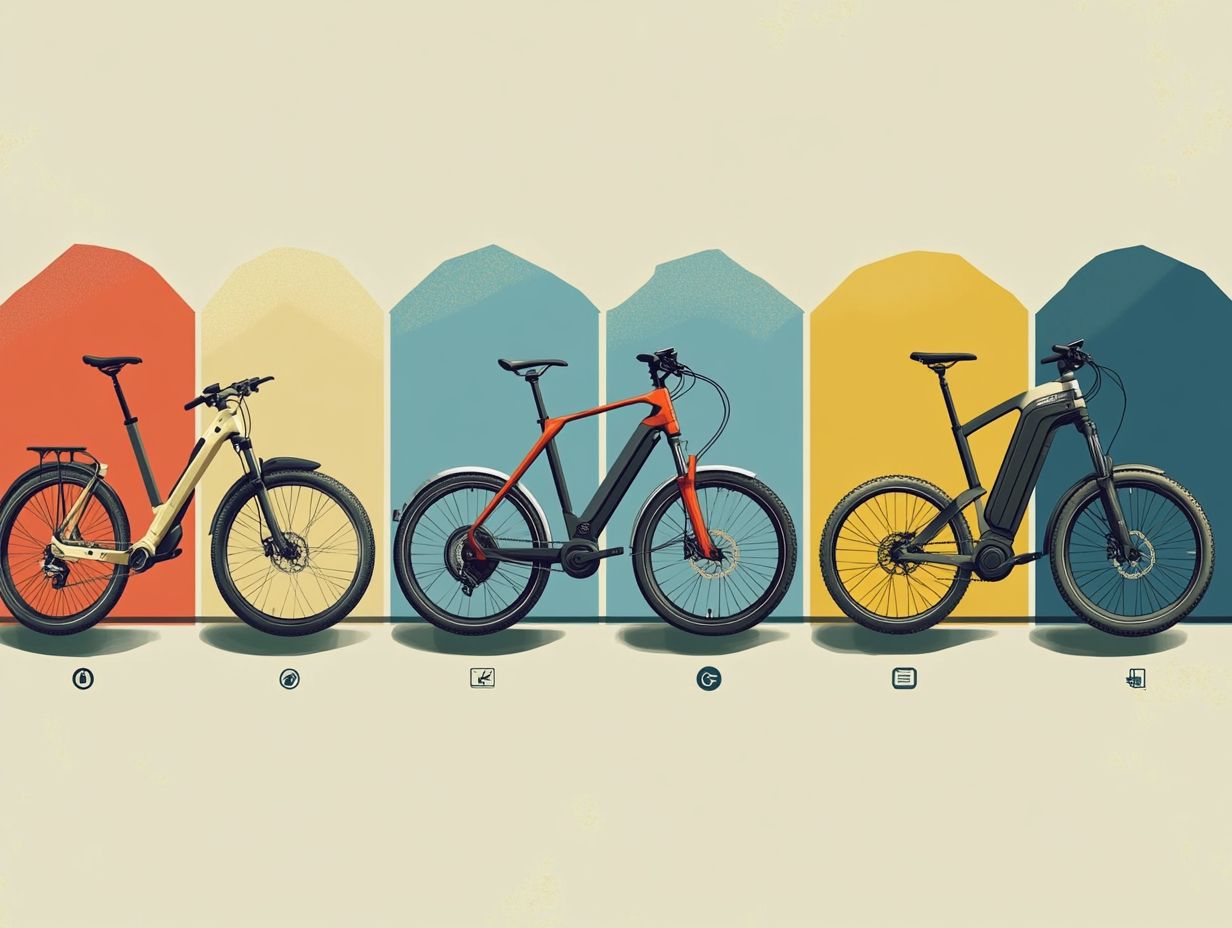
Choosing the right type of e-bike demands thoughtful consideration of your preferences, intended use, and the riding experience you desire. Ensuring that the model you select aligns perfectly with your individual needs is crucial.
To effectively assess what you require, evaluate several factors, including your typical travel distance and the type of terrain you encounter. For example, if your routes are primarily hilly or consist of rough trails, opting for an e-bike with higher motor power and robust tires will likely be essential. Additionally, consider the 5 essential features of commuter electric bicycles to ensure you make the best choice for your needs.
Battery life is another crucial aspect; if you plan on covering longer distances, you’ll want a bike that boasts a reliable battery range, meaning how far you can ride on a single charge, to keep you moving without interruptions. And let’s not overlook personal comfort; taking the bike for test rides can reveal how it feels in various riding positions. For those new to the world of electric bikes, understanding the different options is key, so consider checking out the electric bicycle types: a beginner’s guide to ensure it accommodates your unique preferences and riding style for a truly enjoyable experience.
What Are the Maintenance Requirements for Each Type?
Maintenance requirements for electric bikes differ markedly by type, and grasping these needs is essential for ensuring both longevity and optimal performance, setting them apart from traditional bicycles.
Each model may introduce unique challenges, particularly in terms of battery maintenance, which involves timely charging and careful temperature regulation. Unlike standard bicycles, e-bikes require regular tire pressure checks to account for the additional weight and speed, ensuring a smooth ride while maximizing battery efficiency. If you’re considering e-bikes for leisure, explore various options, including the electric bicycle types for recreational riding.
Brake adjustments are crucial for maintaining the reliable stopping power that is expected from these motorized vehicles. Additionally, safety gear often overlooked in maintenance discussions merits your attention. Regularly inspecting it for wear and tear is vital, as it protects you during your journeys.
What Are the Environmental Impacts of Different E-Bike Types?
The environmental impacts of various e-bike types highlight their potential as sustainable transportation alternatives, shaping your cycling experience toward greener commuting options.
When you explore the total amount of carbon dioxide produced from manufacturing and operating these electric bikes, it becomes clear they offer a significantly lower emission profile compared to traditional gasoline-powered vehicles. Yes, the production of e-bikes does involve some greenhouse gas emissions, but when you consider their overall total emissions during their whole life, they are considerably less especially given their energy-efficient operation.
More people choosing e-bikes means urban areas can look forward to reduced road congestion and improved air quality. This shift not only eases traffic but also promotes healthier lifestyles, elevating e-bikes as an increasingly appealing option for those seeking environmentally responsible transportation solutions.
Frequently Asked Questions
What are the 5 key differences between E-Bike types?
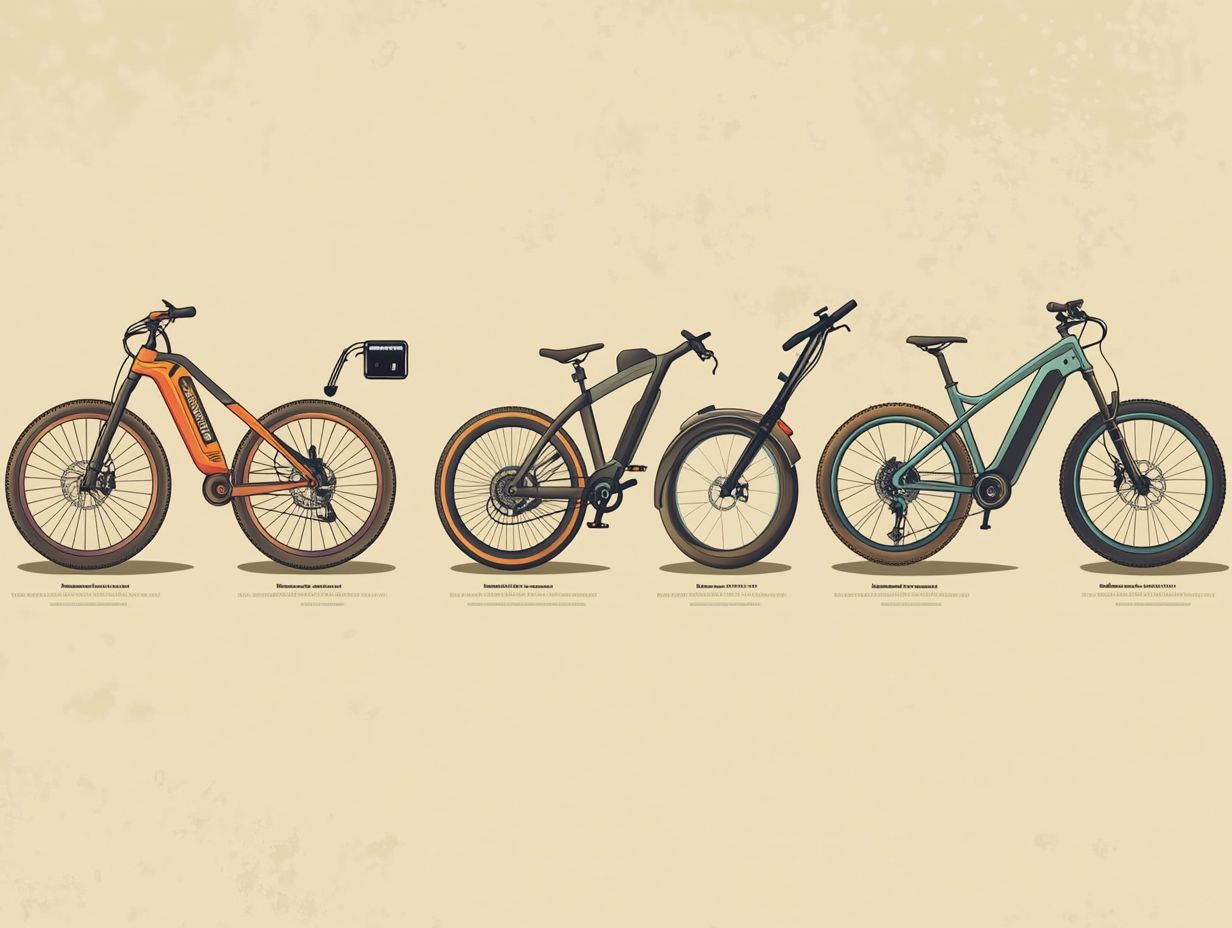
The 5 key differences between E-Bike types are motor placement, pedal assist vs throttle, battery location, maximum speed, and range.
How does motor placement differ among E-Bike types?
Motor placement can vary between front, rear, and mid-drive on different E-Bike types. Front motors provide better handling, rear motors offer more power, and mid-drive motors give a more natural biking experience.
What is the main distinction between pedal assist and throttle E-Bike types?
The main difference between these two types is how the motor is activated. Pedal assist E-Bikes require pedaling to activate the motor, while throttle E-Bikes can be powered solely by the throttle without pedaling.
Where is the battery typically located on E-Bikes?
The battery can be found in various locations on E-Bikes, such as on the rear rack, inside the frame, or on the downtube. Each location offers different benefits and drawbacks in terms of weight distribution and accessibility.
What is the maximum speed of E-Bikes?
E-Bikes have a maximum speed limit that varies based on the type of E-Bike and local regulations. Typically, pedal assist E-Bikes have a maximum speed of 20 mph, while throttle E-Bikes can reach up to 28 mph.
How does range differ among E-Bike types?
The range of an E-Bike, or how far it can travel on a single charge, can vary based on factors like motor type, battery size, and terrain. Generally, pedal assist E-Bikes have a longer range than throttle E-Bikes due to the need for pedaling assistance.
Join the green revolution! Choose an e-bike for your next adventure and make a difference today!


